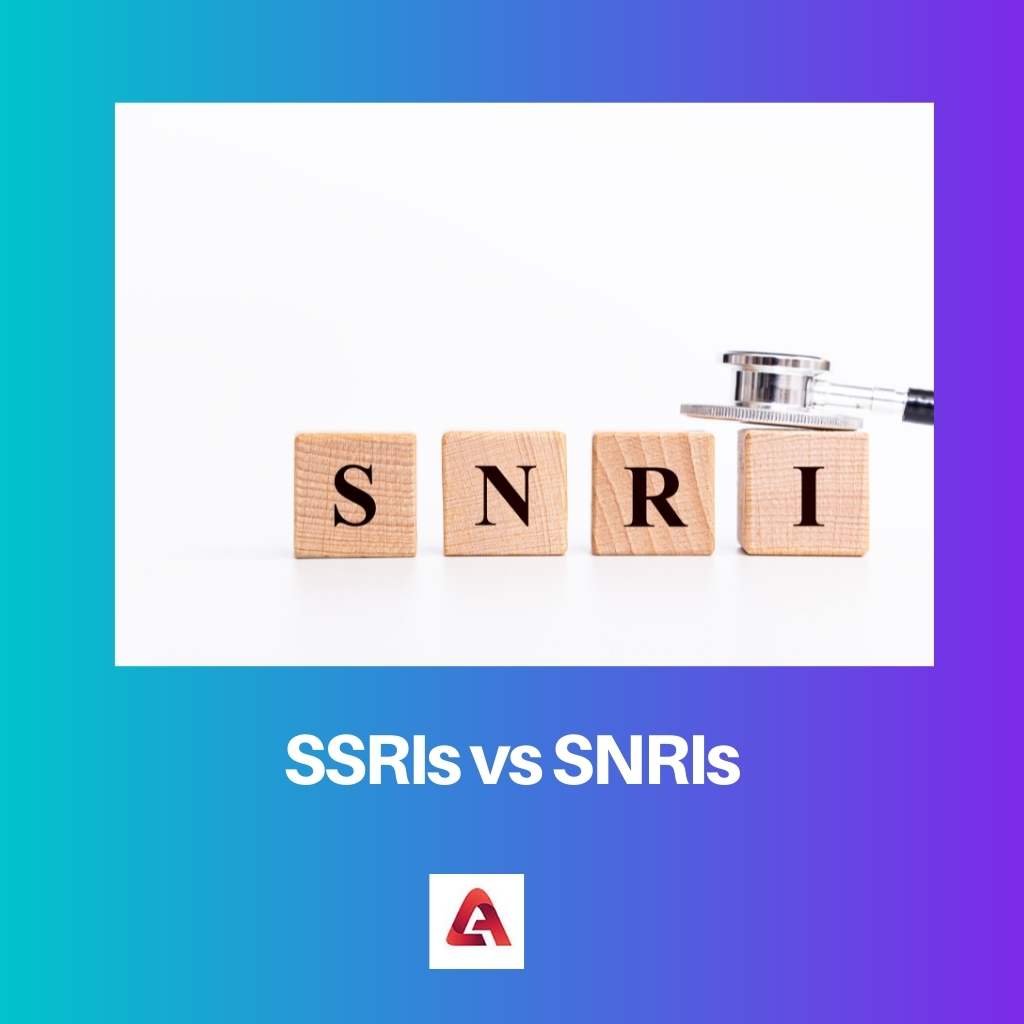SSRIs and SNRIs are both different types of anti-depressants. Anti-depressants are medications used to treat depression, anxiety orders, chronic pain conditions, and addictions.
There are different types of anti-depressants present to treat different levels of anxiety levels and depression. SSRIs and SNRIs are anti-depressants that act as neurotransmitters that carry nerve signals between neurons.
Key Takeaways
- SSRIs are Selective Serotonin Reuptake Inhibitors, while SNRIs are Serotonin and Norepinephrine Reuptake Inhibitors.
- SSRIs primarily treat depression and anxiety disorders, while SNRIs treat depression, anxiety disorders, and chronic pain.
- SSRIs work by increasing the levels of serotonin in the brain, while SNRIs work by increasing the levels of serotonin and norepinephrine in the brain.
SSRIs vs SNRIs
The difference between SSRIs and SNRIs is that SSRIs inhibit the reuptake of serotonin levels in the brain, while SNRIs inhibit the reuptake of both serotonin and norepinephrine levels. Both tablets are anti-depressants, but SSRI is used as a first-level antidepressant to treat moderate depressive disorder, while SNRI is used to treat major depressive disorders.

SSRIs are anti-depressants drugs that are medications used to fight depression, anxiety orders, and other psychological conditions. It helps in improving mood. It limits the reabsorption of serotonin in a person’s body.
The medication is used to treat social anxiety disorder, obsessive-compulsive disorder, eating disorder, etc.
SNRIs are used to treat major depressive disorders like PTSD, Neuropathic pain, Etc. They are monoamine reuptake inhibitors.
The dual inhibition of serotonin and norepinephrine reuptake helps to treat wider symptoms. Some examples of SNRIs are Venlafaxine, Desvenlafaxine, etc.
Comparison Table
| Parameters of Comparison | SSRIs | SNRIs |
|---|---|---|
| Full form | Selective serotonin reuptake inhibitors. | Serotonin and norepinephrine reuptake inhibitors. |
| Neurotransmitters | It prevents the reuptake of Serotonin neurotransmitters. | It prevents or limits the reuptake of Serotonin and Norepinephrine neurotransmitters. |
| Treatment of diseases | Eating disorders, chronic pain, OCD, major depressive disorder, etc. | PTSD, SAD, OCD, Neuropathic pain, etc. |
| Side-effects | Rashes, Nose bleeds, Sexual dysfunction, and an increase in violent acts, are some of the common side effects. | Constipation, Nausea, Physical weakness, etc are some of the common side effects. |
| Examples | Some examples of SSRIs are Fluvoxamine, Vilazodone, Citalopram, etc. | Some examples of SNRIs are Venlafaxine, Desvenlafaxine, etc. |
What are SSRIs?
SSRIs stand for Selective serotonin reuptake inhibitors. SSRIs are anti-depressants drugs that are medications used to fight depression, anxiety orders, and other psychological conditions.
It is one of the most prescribed anti-depressants in many countries as it is the first-line treatment for severe depression. SSRIs help in improving mood and fighting depression.
SSRIs limit the reuptake or reabsorption of serotonin in a person’s body. It prevents the neurotransmitter from being reabsorbed back into the nerve cell.
Serotonin helps to regulate the mood in the body. When a person is depressed, serotonin is either too high or too low in a person’s body.
It also regulates a person’s waking and sleeping routines.
Some of the illnesses for which SSRIs are given as anti-depressants are Major depressive disorder, social anxiety disorder, obsessive-compulsive disorder, eating disorder, chronic pain, etc.
This medication has some side effects as well, such as sweating, rashes, nose bleeds, and sexual dysfunction, and it can increase violent acts, etc.
Seizures and allergic reactions can also happen however, they are so rare. Also, SSRIs increase the risks of abortion in pregnancy therefore, these medicines can only be taken under doctors’ guidance.
Some of the SSRIs are fluvoxamine, vilazodone, citalopram, sertraline, escitalopram etc. Some SSRIs are also used to decrease anger, like sertraline.
What are SNRIs?
SNRIs stand for Serotonin-norepinephrine reuptake inhibitors. SNRIs are anti-depressants as well. SNRIs are monoamine reuptake inhibitors, which means the drug reacts on one or more of three major neurotransmitters.
SNRIs elevate and prevent the reuptake of both serotonin and norepinephrine. Serotonin and Norepinephrine are both neurotransmitters.
Indeed, Norepinephrine functions as a hormone as well. These neurotransmitters regulate the mood of a person.
SNRIs are second-generation anti-depressants. These second-generation anti-depressants have taken over the first-generation anti-depressants.
SNRIs increase the levels of norepinephrine, which eventually helps a person concentrate and reduces depression. They are taken in the form of tablets, mostly in the morning time as they can cause insomnia if taken at night time.
SNRIs are used to fight Post-traumatic stress disorder (PTSD), Social Anxiety Disorder, Neuropathic pain, chronic musculoskeletal pain, Fibromyalgia, etc. SNRIs have side effects as well, such as constipation,
nausea, loss of appetite, dry mouth, physical weakness, etc. Indeed, these medications can be addictive as well. It can also cause side effects when the medication is withdrawn.
Some of the SNRIS are venlafaxine, desvenlafaxine, levomilnacipran, duloxetine, etc.
SNRIs treat a wider range of symptoms as dual inhibition of serotonin and norepinephrine reuptake takes place and so it offers more advantage over other anti-depressant tablets.
Main Differences Between SSRIs And SNRIs
- SSRIs inhibit the reuptake of serotonin levels in the brain, while SNRIs inhibit the reuptake of both serotonin and norepinephrine levels.
- SSRIs are less cost-effective, while SNRIs are more cost-effective.
- SSRI is less preferred than SNRI as SNRI treats a wider range of symptoms.
- SSRI is more tolerant than SNRI
- SSRI is used to treat moderate to severe depression disorders, while SNRI is used to treat major depressive disorders.
- SSRI is a third-generation anti-depressant, while SNRI is a second-generation anti-depressant.
- Example of SSRIs is fluvoxamine, vilazodone, citalopram, sertraline, escitalopram, etc. Example of SNRIs is venlafaxine, levomilnacipran, duloxetine, etc.

- https://europepmc.org/article/med/18668017
- https://www.psychiatrist.com/wp-content/uploads/2021/02/25789_snris-versus-ssris-mechanisms-action-treating-depression.pdf
- https://www.cambridge.org/core/journals/cns-spectrums/article/snris-pharmacology-clinical-efficacy-and-tolerability-in-comparison-with-other-classes-of-antidepressants/85CE6083A8FDE2FA95B5F44D304D987F
- https://onlinelibrary.wiley.com/doi/abs/10.1111/j.1365-2710.2009.01050.x